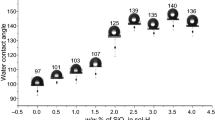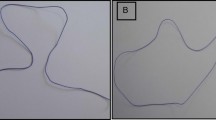Modern suturing materials are developed with a focus on the requirements of surgeons for the optimum mechanical characteristics; interchangeability; compatibility; safety; a lack of allergic, teratogenic, and cancerogenic action in vivo; and a lack of capillary action. Biologically active (BA) thread with a complex action that was prepared by impregnating polyamide or polyester thread-base with a modified composition based on the biopolymer chitosan and including the antibacterial preparation ciprofloxacin and the germanium-containing preparation Astragerm-C was selected for the studies. The goal was to study the effects of the selected modification method and the composition of the modifier on the functional properties of a new surgical suturing material. It was shown that the produced surgical suturing material had improved functional properties that comply with modern requirements.
Translated from Khimicheskie Volokna, No. 1, pp. 57–62, January-February, 2011.



Similar content being viewed by others
References
A. G. Arakelyan, S. A. Pak, and S. A. Tetera, Modern Suturing Materials or How a Surgeon Makes the Optimal Selection of Suturing Material [in Russian], Kharkov (2004), p. 3–4.
S. I. Shkurenko, A. V. Genis, et al., Plast. Massy, No. 3, 52–55 (2006).
RF Pat. No. 2,309,768; Publ. Nov. 10, 2007.
RF Pat. No. 2,239,420; Publ. Nov. 10, 2004.
“Biodegradable coatings based on chitosan for improvement of the properties of textile medical devices contacting blood,” in: Proceedings of the Eighth International Conference “Current Potential in Chitin and Chitosan Research” [in Russian], VNIRO, Kazan (2006), p. 219.
K. G. Skryabin, G. A. Vikhoreva, and V. P. Varlamov (eds.), Chitin and Chitosan: Preparation, Properties and Application [in Russian], Nauka, Moscow (2002), p. 368.
S. M. Nasibov, I. N. Bol’shakov, and D. V. Kulaev, in: Proceedings of the Third All-Union Conference “Improvement of Chitin and Chitosan Production from Krill-shell-containing Wastes and Routes for Their Use” [in Russian], VNIRO, Moscow (1992), pp. 63–71.
I. N. Bol’shakov, S. M. Nasibov, et al., in: Chitin and Chitosan [in Russian], K. G. Skryabin, G. A. Vikhoreva, and V. P. Varlamov (eds.), Nauka, Moscow (2002), p. 280.
V. F. Mironov and T. K. Gar, Biological Activity of Germanium Compounds. A Review [in Russian], NIITeKhIM, Moscow (1982), p. 27.
A. N. Sergeev, E. M. Mokhov, and S. I. Sergeeva, “Evaluation of the operation-wound-healing process in patients with emergency abdominal surgical pathology from an investigation of the antibacterial activity of the wound exudate” [in Russian], in: Abstracts of Papers of the VIth All-Russian Conference of General Surgeons Combined with the VIth Uspenskii Readings [in Russian], p. 62.
E. Ya. Lukevits, S. K. Termane, et al., Khim.-farm. Zh., No. 2, 154–159 (1984).
A. I. Gamzazade, S. M. Nasibov, and O. V. Lukin, “Antibacterial activity of chitosans” [in Russian], in: Proceedings of the Eighth International Conference “Current Potential in Chitin and Chitosan Research” [in Russian], VNIRO, Kazan (2006), p. 183.
V. I. Egiev, V. M. Buyanov, et al., Surgical Suturing [in Russian], Medpraktika, Moscow (2001), p. 28.
A. I. Suvorova, I. S. Tyukova, and Yu. N. Zamuraeva, in: Proceedings of the Seventh International Conference “Current Potential in Chitin and Chitosan Research” [in Russian], VNIRO, St. Petersburg (2003), pp. 52–53.
GOST R 53005 – 2008. “Surgical suturing materials. General technical requirements. Test methods” [in Russian].
T. I. Vinokurova and S. M. Kiryukhin, Izv. Vyssh. Uchebn. Zaved. Tekhnol. Tekst. Promst., No. 4, 15–18 (1996).
L. A. Vol’f, “Suturing materials based on biologically active synthetic and artificial fibers” [in Russian], in: Abstracts of Papers of the First All-Union Conference, Moscow (1989), p. 189.
Author information
Authors and Affiliations
Rights and permissions
About this article
Cite this article
Rykalina, V.E., Shkurenko, S.I., Monakhova, E.V. et al. Improved functional properties of surgical threads by surface modification with polymer composites. Fibre Chem 43, 68–74 (2011). https://doi.org/10.1007/s10692-011-9309-0
Published:
Issue Date:
DOI: https://doi.org/10.1007/s10692-011-9309-0




